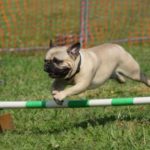Rally training, also known as Rally Obedience, is a team sport for dogs that has become increasingly popular over the years.
If you’re interested in learning more about Rally training for your dog, this article is here to help.
In this article, I will explore all you need to know about rally training, so you can gauge whether it sounds like the right sport for you and your dog.
Let’s get started.

What Is Rally Training For Dogs?
Rally Obedience is a sport that dogs of all breeds can enjoy. Rally is a hybrid of classical obedience training and agility training.
Rally is more than just dog training. You and your dog have a partnership and are a team, which is why teamwork is at the heart of Rally training.
To be successful at Rally, it takes both of you working together seamlessly, which is why your bond with your dog and clear communication is also vital.
Rally helps you to develop that special bond with your dog, while teaching them skills to apply to everyday tasks in life.
Rally training involves a course made up of signs, with each sign representing turns or commands such as stay, sit, and down that need to be completed by the dog and their handler.
In this sense, Rally training mimics real life situations that you and your dog will encounter, which is why it’s so great for their obedience training.
You begin with a perfect score of 100, and get points deducted along the way. If your team retains a score of at least 70 points, then you could be in with a chance of earning a title.
This comes down to the fact that if you qualify the required number of times, then you’re allowed to move onto the next level.
When your dog participates in Rally training, they experience the fun and mental stimulation that agility provides them, while also learning how to obey a variety of different commands.
In addition to this, you will build a strong bond with your dog that will help with their overall behavior on and off the course.
You won’t believe how quickly they will be able to pick up new commands when you enroll them in Rally training, as it provides an excellent foundation for learning new skills.
How Do You Get Your Dog Into Rally?
To begin, you should enroll your dog in a Rally class!
You can even observe a class before you commit to signing up if you’d feel more comfortable doing that, as this will help you gauge whether it’s suitable for you and your dog before signing up.
You won’t be able to start Rally training until your dog is at least six months old. However, this doesn’t mean that you can’t lay the foundations before this when you’re teaching them commands at home.
When they are old enough, enrolling them in a Rally class is a great way of introducing them to the sport while they’re still young and will do wonders for their obedience skills.
That being said, the younger your dog is, the shorter their Rally sessions should be.
It’s best that your dog participates in frequent short sessions in combination with play time and rewards, as opposed to longer sessions, as this method is much more effective and stimulating for them.
What Does A Rally Training Session Involve?
As there are a wide variety of signs to choose from in Rally training. As a result, the exercises are consistently changing to ensure that you and your dog are mentally stimulated.
Rally training is a fairly easy sport for you both to engage in.
It involves walking your dog through the course at a brisk pace, before stopping at appointed stations that have signs with instructions on the skill to perform.
It is your responsibility as the handler to interpret these signs and instruct your dog accordingly. How challenging the Rally course is will depend on the experience of the team that is participating.
The American Kennel Club recognizes a variety of different classes. Which class you’re in will depend on your team’s experience and whether you’ve qualified for the next class.
Novice – When you first start out in Rally training, you will begin in a Novice class. There are 10 to 15 different signs and your dog will always be handled on their leash. In Novice classes, you can talk, pat their legs, and encourage your dog to perform each command.
Intermediate or Advanced – The next level is Intermediate or Advanced classes, which the handler will be able to choose between depending on which one they feel like they’re comfortable participating in.
There are 12 to 17 signs. In an Intermediate class, your dog will be on a leash and there are no jumps. However, in an Advanced class, all of the exercises are off the leash and there is one jump required.
Excellent – Excellent classes are the next level of competition, and require your dog to perform all of their exercises off the leash. There are 15 to 20 signs, and to earn a title your dog must earn three qualifying scores.
Handlers can’t clap or pat their dogs legs to encourage them through the exercises, and their dogs must jump at least once.
Master – Once you reach Master, you are at the highest level of competition. All of the exercises must be performed off the leash and there are 15 to 20 signs.
In Master classes, handlers are not allowed to pat their dogs legs to encourage them, and their dogs must jump at least once. In order to win a title, your dog must earn ten qualifying scores.
As the level of the competition increases, the number of signs increases along with the difficulty of the exercises that your dog is required to perform. Should you wish to and when you feel ready, you and your dog can compete in Rally!
However, there are a few things that you should know about competing before you sign yourself up.
Notes On Competing In Rally
- Although you can prepare your puppy when they are smaller, in order to compete in Rally and take Rally classes, your dog must be at least 6 months or older.
- Females in season are not allowed to compete in Rally. However, female dogs that have been spayed and male dogs that have been neutered are allowed to compete whenever.
- While dogs who are deaf are allowed to participate in Rally, blind dogs unfortunately aren’t eligible to compete.
- Your dog can’t compete in Rally if they are injured and have been taped up as a result of a medical condition or issue.
In Summary
Rally training is a good sport to get your dog to participate in for many reasons.
Whether you want to compete with your dog or not, this type of training can do wonders for your dog’s obedience in daily situations while the agility side of the sport works to keep your dog fit and healthy.
Now you’ve got a better idea of what Rally entails, why not enrol your dog to a few classes to see how they get on?
Good luck and enjoy Rally training!
- 8 Signs That Your Dog Is In Heat - November 8, 2022
- Why Is My Dog Whining Whilst Carrying A Toy In Their Mouth? - August 17, 2022
- Reasons Why Your Dog’s Poop Is White And What To Do About It - August 17, 2022









